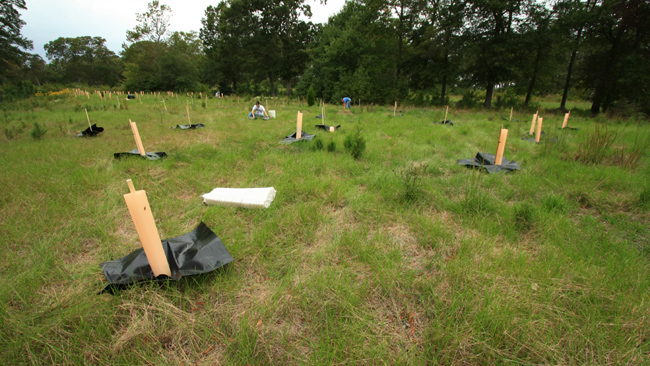Photo from the field
Planting trees for wildlife and people!
by Ben Wurst, Habitat Program Manager

For the past 3 years Conserve Wildlife Foundation of NJ has been working to restore habitat at an old golf course in lower Cape May County. We have concentrated on reforesting many of the old fairways at the site, now known as Cape Island Wildlife Management Area. This past week we planted around 300 native tree seedlings from Pinelands Nursery there. All of the species planted will benefit wildlife by providing food and cover. It will increase biodiversity and reduce fragmentation of forested habitat. We planted white and scarlet oak, pitch pine, gray birch, bayberry, serviceberry, persimmon, beach plum, and tulip poplar. Seedlings are protected by tree tubes (help reduce light browse by deer and rabbits) and weed mats (reduce competition from cool season grasses) to help increase survival rates.
Trees also benefit you and I. They capture carbon dioxide and release oxygen. Planting trees is one of the most effective and least expensive ways to reduce carbon in the atmosphere. They can reduce heating and cooling costs if planted around your home. They can also help increase your home’s property value. Fall is the best time to plant trees. When planting a tree make sure to dig the hole twice as deep and twice as wide as the root ball. Plant to a depth where the collar of the truck is not below ground level. Amend the soil if necessary and only put up to 2″ of mulch against the trunk. Here are my picks for best native trees to plant for wildlife (and you) in your yard:
Shade trees: Sweet gum (awesome fall foliage!), tulip poplar (great pyramidal shape when mature, great shade tree), oak spp. (produce acorns and good shade trees, scarlet oaks have stunning fall foliage). Plant these on the south side of your house to reduce cooling costs in summer.
Conifers: red cedar (good wind break, dense cover for wildlife, provide berries for songbirds), american holly (beautiful red berries in winter, good cover for wildlife from heavy snow). Plant these along the NW side of your house to act as a windbreak from cold winter winds.
Watch a video clip about our work at Ponderlodge that was featured on NJTV on September 22.
- Tree planting at Ponderlodge on NJTV (scroll to 20:00 minutes into the video to see the clip).
Discover more from Conserve Wildlife Foundation of NJ
Subscribe to get the latest posts sent to your email.